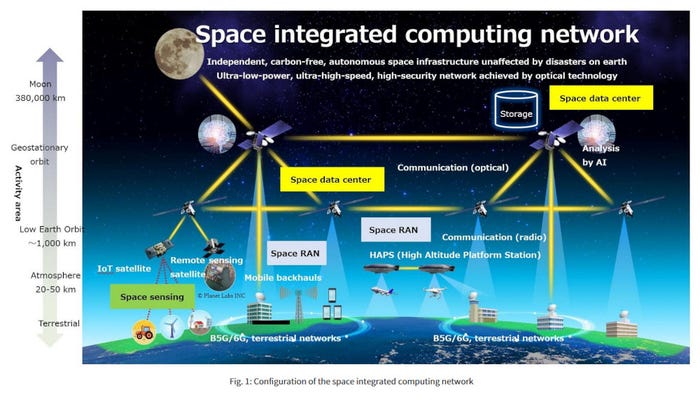NTT to launch data centres into space within five years
NTT and SKY Perfect JSAT have announced plans to work together to build an integrated computing network in space that will include, among other things, space-based data centres.
May 21, 2021

NTT and SKY Perfect JSAT have announced plans to work together to build an integrated computing network in space that will include, among other things, space-based data centres.
The Japanese operator is essentially pitching this as a CSR initiative, talking up the role of the new space business in helping work towards a sustainable society. But the technology is pretty interesting too.
NTT and SKY Perfect JSAT – a satellite communications and broadcasting company, for those unfamiliar with it – have teamed up to build a new space infrastructure. It will bring together NTT’s network and computing infrastructure with SKY Perfect JSAT’s space assets to create a network of satellites connected to each other and to the ground via optical wireless technology to form a constellation and to facilitate distributed computing in space.
Ultimately, it’s all about data processing in space rather than on earth. The joint announcement from NTT and SKY Perfect JSAT is a little complex, but Nikkei, which got hold of the news before it was public knowledge, explains it pretty well. Large amounts of data can be gathered by satellites and analysed in space, rather than having to be sent back to earth for processing, thereby dramatically reducing the amount of data traffic and, as a knock-on effect, power consumption.
NTT satellites, plus a new space and earth sensing platform that will use low earth orbit satellite MIMO technology, will collect data from IoT terminals positioned around the earth. It seems the firms will collect environmental information, data from farms, offshore wind terminals, autonomous vehicles and so forth.
The firms also have another string to their bow, which is a space RAN project. A low-earth orbit (LEO) satellite and high-altitude platform station (HAPS) will enable them to build a mobile communications platform and use to launch a mobile access network. Possible applications include high-reliability messaging services or ultra-wide-area coverage, they said.
“We will conduct technical demonstrations beginning in 2022 to develop technologies that will lay the foundation for these projects,” the companies said. “In parallel, we will prepare for the launch of commercial satellites, which will be planned to start its commercial services from around 2025.”
They did not specify how many satellites they envisage launching, but Nikkei put the number at hundreds each in the future. Whatever the actual figure, the skies are starting to get pretty crowded, with the likes of SpaceX, OneWeb and many others launching thousands of satellites to serve their mobile communications businesses. The NTT/SKY Perfect JSAT is a different proposition, centring as it does around data centres and data processing in space, but the companies are still very much a part of the ongoing space race.

About the Author(s)
You May Also Like











_1.jpg?width=700&auto=webp&quality=80&disable=upscale)


.png?width=800&auto=webp&quality=80&disable=upscale)